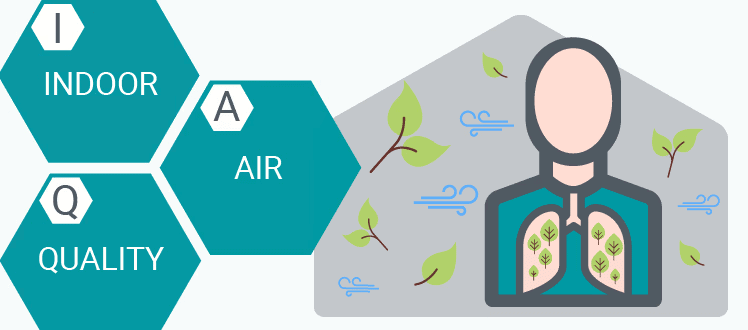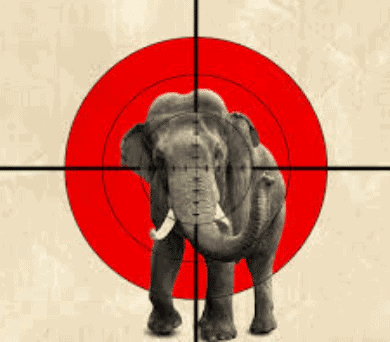Environment and Ecology: April 2025 Current Affairs | Current Affairs & General Knowledge - CLAT PDF Download
| Table of contents |

|
| Indoor Air Quality (IAQ) and Its Importance |

|
| Elephant Poaching in Tamil Nadu |

|
| India’s Air Pollution Crisis |

|
| Growing Threat of Light Fishing in India |

|
Indoor Air Quality (IAQ) and Its Importance

Why in News?
Indoor air pollution is increasingly recognized as a significant issue in India, particularly in urban environments where individuals spend 70–90% of their time indoors. Despite this, discussions surrounding Indoor Air Quality (IAQ) are often limited, with most policies still focusing on outdoor pollution.
Key Takeaways
- Indoor air quality (IAQ) refers to the quality of air inside and around buildings, affecting the health and comfort of occupants.
- Common indoor air pollutants include carbon monoxide, formaldehyde, asbestos, radon, lead, mould, pesticides, smoke, and allergens.
Additional Details
- Common Indoor Air Pollutants:
- Carbon Monoxide (CO): A toxic, odorless gas resulting from incomplete combustion.
- Formaldehyde: Found in wood products, glues, and paints; recognized as a carcinogen.
- Asbestos: Present in older construction materials; exposure can lead to serious lung diseases.
- Radon: A radioactive gas that infiltrates buildings from the ground.
- Lead: Commonly found in older paints and plumbing materials.
- Mould: A type of fungus that thrives in damp environments.
- Pesticides: Chemicals used for pest control that contribute to indoor pollution.
- Smoke: Emitted from cigarettes or cooking stoves, containing harmful toxins.
- Allergens: Dust mites, pet dander, and pollen that accumulate in indoor spaces.
- Reasons for Deteriorating IAQ:
- Outdoor pollutants, such as particulate matter (PM2.5), can infiltrate poorly sealed buildings.
- Indoor activities, including cooking and smoking, contribute to elevated pollution levels.
- Overcrowding in urban housing exacerbates indoor pollution due to limited ventilation.
- A lack of public awareness and regulatory standards allows harmful practices to continue.
- Impact:
- India has the highest average indoor PM2.5 levels globally, according to Dyson's study.
- Household air pollution causes approximately 3.2 million premature deaths annually worldwide (WHO).
- Poor ventilation leads to carbon dioxide accumulation, resulting in “sick building syndrome.”
- Indoor air pollution is associated with noncommunicable diseases like stroke and lung cancer, disproportionately affecting women and children.
- Solutions to Indoor Air Pollution:
- Use air purifiers with High Efficiency Particulate Air (HEPA) filters to capture harmful pollutants.
- Certain indoor plants, like spider plants and peace lilies, can help absorb indoor pollutants.
- Switch to cleaner fuels and technologies such as solar power, biogas, or natural gas for cooking.
- Reduce the use of volatile organic compounds (VOCs) in paints and building materials.
- Adopt health-focused building practices in collaboration with the Indian Green Building Council (IGBC).
Improving indoor air quality is crucial for public health. Awareness and proactive measures can significantly mitigate the risks associated with indoor air pollution, leading to healthier living environments.
Elephant Poaching in Tamil Nadu

Why in News?
A recent incident of elephant poaching in Tamil Nadu has raised significant concerns regarding the resurgence of wildlife crimes, posing a serious threat to the survival of wild elephants. According to the Ministry of Environment, Forest and Climate Change (MoEFCC), the elephant population in India decreased from over 4,000 in 2012 to approximately 2,800 in 2017, but has shown signs of recovery, reaching over 3,000 by 2024.
Key Takeaways
- Elephants are recognized as a National Heritage animal of India.
- They are matriarchal creatures, living in groups led by females.
- Elephants are considered a 'Keystone Species,' crucial for maintaining the balance and health of forest ecosystems.
Additional Details
- About Elephants: Elephants play a vital role as ecosystem engineers. They facilitate seed dispersal and create access to water sources for other species.
- Species:There are two primary species of elephants:
- Asian Elephants (Elephas maximus)
- African Elephants:
- African Savannah Elephants (Loxodonta africana)
- African Forest Elephants (Loxodonta cyclotis)
- Population in India: Indian elephants are a subspecies of Asian elephants, accounting for around 60% of the total Asian elephant population. In 2017, the elephant census indicated approximately 29,964 elephants in India, with Karnataka having the highest population, followed by Assam and Kerala. The Sathyamangalam forest division is noted for having the most elephants.
- Threats:Major threats to elephants include:
- Ivory trade
- Human-animal conflict
- Inter-state and transnational wildlife trafficking
- Conservation Status:
- Convention of the Migratory Species (CMS): Appendix I
- Wildlife (Protection) Act, 1972: Schedule I
- Related Initiatives:
- Project Elephant: Launched in 1992 to protect elephants and their natural habitats.
- Elephant Reserves & Corridors: India has 33 elephant reserves and 150 elephant corridors.
- Project RE-HAB: This initiative aims to prevent elephant-human conflicts by installing bee-fences, reducing both conflicts and retaliatory killings.
Global awareness for elephant conservation is highlighted by events such as World Elephant Day, observed annually on 12th August, which aims to raise awareness about the urgent need to protect and conserve elephants. Additionally, the Monitoring of Illegal Killing of Elephants (MIKE) Programme is an international initiative that tracks elephant mortality trends to support conservation efforts in Asia and Africa.
Difference Between Asian and African Elephants
| Feature | Asian Elephants | African Elephants |
|---|---|---|
| Geographical Range | 13 countries across South & Southeast Asia (including India, Sri Lanka, Myanmar, etc.) | Sub-Saharan Africa (Savannahs & Rainforests) |
| Size | Smaller in size with proportionally smaller ears | Larger in size (largest land animals on earth) |
| Tusks | Most males have tusks; females are usually tuskless or have tiny tusks | Both males and females have large visible tusks |
| Trunk | They have just one ‘finger-like projection’ at the tip of their trunk | They have two ‘finger-like projections’ at the tip of their trunk |
| Skin Texture | Smoother, may have pinkish freckles (depigmentation) | Wrinkled skin that retains moisture (adaptation to dry climates) |
| Conservation Status (IUCN) | Endangered | African Forest Elephant: Critically Endangered; African Savannah Elephant: Endangered |
India’s Air Pollution Crisis

Introduction
India is facing a serious and ongoing air pollution problem that is causing major health issues for its people. Many cities in India are consistently ranked among the most polluted in the world.
According to the World Air Quality Report 2024.
- Thirteen out of the twenty most polluted cities globally are in India, with Byrnihat, located on the Assam-Meghalaya border, being the most polluted.
- India is the fifth most polluted country in the world, with an average Air Quality Index (AQI) of 50.6 μg/m3. This is ten times higher than the World Health Organization’s (WHO) guideline of 5 μg/m3 for annual PM2.5 levels.
- Delhi remains the most polluted capital city in the world, with an average PM2.5 concentration of 91.8 μg/m3.
What is Air Pollution?
Air pollution occurs when harmful substances, such as particles, gases, or other matter, are released into the air, reducing its quality.
Common air pollutants include:
- Particulate Matter (PM)
- Nitrogen Dioxide (NO2)
- Sulfur Dioxide (SO2)
- Ozone (O3)
- Carbon Monoxide (CO)
- Volatile Organic Compounds (VOCs)
- Lead
Sources:
- Air pollutants can come from natural sources like volcanic eruptions and wildfires. However, human activities such as industrial production, transportation, agriculture, and residential heating are major contributors to air pollution.
Concerns:
- Health Related: Air pollution can lead to various health issues, including respiratory problems, cardiovascular diseases, and reduced lung function.
- Environmental: Air pollution damages ecosystems, causes biodiversity loss, pollutes water, contributes to climate change, and harms crops.
- Healthcare Costs: The health impacts of air pollution result in increased healthcare expenses for treating diseases related to respiratory and cardiovascular issues.
Reasons for High Level of Air Pollution in India
- Vehicular Emissions: The large number of old and inefficient vehicles, along with a reliance on diesel and petrol, significantly contributes to air pollution.
- Industrial Emissions: Major industries, particularly coal-based power plants, are significant sources of air pollution.
- Burning of Biomass: The practice of burning crop residues and using solid fuels like wood and cow dung for cooking in rural areas contributes to air pollution.
- Construction Dust: Rapid urbanization leads to increased construction activities, generating substantial amounts of dust and particulate matter.
- Waste Burning: Open burning of garbage and waste is common, especially in urban and semi-urban areas, releasing harmful pollutants into the air.
- Population Density: Overcrowded cities with high levels of vehicular traffic and industrial activity experience elevated pollution levels.
- Climate and Geography: Seasonal weather patterns, particularly during winter, can trap pollutants in the air, worsening smog and haze.
- Deforestation: The loss of green cover reduces the natural filtration of air, leading to higher pollution levels.
Government Initiatives
- National Clean Air Programme (NCAP): Launched in 2019, NCAP aims to reduce air pollution in identified cities and regions across India. It focuses on improving air quality monitoring, implementing stricter emission standards, and raising public awareness.
- Bharat Stage VI (BS-VI) Emission Standards: Implemented in 2020, BS-VI standards aim to reduce vehicular emissions by mandating the use of cleaner fuel and advanced emission control technologies.
- Pradhan Mantri Ujjwala Yojana (PMUY): This scheme promotes the use of liquefied petroleum gas (LPG) for cooking in households, reducing reliance on traditional biomass-based cooking methods.
- FAME (Faster Adoption and Manufacturing of Hybrid and Electric Vehicles) Scheme: This scheme encourages the adoption of electric and hybrid vehicles to reduce air pollution from vehicular emissions by providing incentives to manufacturers and consumers.
- Green Initiatives for Sustainable Habitat (GRIHA): GRIHA promotes sustainable and environmentally friendly practices in building construction and operation, encouraging energy-efficient technologies and materials.
- Waste Management Programs: Initiatives like the Swachh Bharat Abhiyan aim to address solid waste issues and promote cleaner disposal methods to prevent waste burning, which contributes to air pollution.
- Commission for Air Quality Management: This Commission focuses on Air Quality Management in the National Capital Region and adjoining areas, enhancing coordination, research, and problem-solving related to air quality issues.
- Afforestation Programs: Initiatives such as the Green India Mission aim to increase tree cover, which helps absorb pollutants and improve air quality.
Way Ahead
- National Targets: India aims to reduce PM2.5 levels by 40% by 2026. To achieve this, detailed local data is necessary, including information on vehicle types, fuel used, and traffic patterns. Currently, the lack of such data affects fund utilization and prioritizes air pollution as a secondary concern for municipalities.
- Avoiding the “Western Trap”: India should avoid over-relying on high-tech solutions and urban-centric approaches that may overlook basic pollution sources like biomass burning, outdated industrial processes, and polluting vehicles. The strategy should be grounded in local realities rather than imported models.
- Focus on Implementation: There is a need for separate funding streams for research and immediate interventions. The emphasis should be on short-term, scalable solutions that can be implemented effectively.
- Global Guidance: Countries like China, Brazil, California, and London offer valuable lessons on contextual and tailored approaches to air quality management. India should innovate based on its unique needs, considering federalism and informal economies.
Growing Threat of Light Fishing in India
 Why in News?
Why in News?
India's extensive 7,500-km coastline, rich in marine biodiversity and home to millions of fishers, faces a significant challenge from illegal light fishing. Despite a ban on this practice within the Exclusive Economic Zone (EEZ) that has been in place since 2017, weak enforcement has allowed it to continue, leading to urgent calls for action to mitigate the ecological and social repercussions.
Key Takeaways
- Illegal light fishing poses a threat to marine life and traditional fishing communities.
- Current enforcement of fishing regulations is inconsistent across different states.
- Light fishing results in environmental degradation and depletes fish stocks.
Additional Details
- What is Light Fishing? Light fishing is the practice of using high-intensity artificial lights to attract fish and squid to the surface, making them easier to catch. It is prohibited under the National Policy on Marine Fisheries (NPMF) of 2017, which seeks to protect marine resources and promote sustainability.
- Impacts: This method leads to the indiscriminate capture of fish, including juvenile species, which threatens future fish populations. It disrupts marine ecosystems and degrades habitats like coral reefs. Species such as squid, crucial to the marine food web, are particularly affected, leading to cascading impacts on larger predator species.
- Light fishing has adverse effects on traditional fishers’ catches, particularly in states such as Andhra Pradesh, Maharashtra, and Kerala, where competition with mechanized trawlers using powerful lights creates tension between industrial operators and local communities.

Challenges in Enforcement
- Weak Policy Framework: Although a national ban exists, enforcement responsibility within territorial waters (up to 12 nautical miles) lies with the states, leading to inconsistencies in regulation. Some states, like Tamil Nadu and Andhra Pradesh, have only partial bans.
- Institutional Capacity Gaps: The Coastal Police can patrol only up to 5 nautical miles, while light fishing typically occurs beyond this range.
- Inadequate Penalties: Current fines, such as Rs 16,000 in Karnataka, are minimal compared to profits of up to Rs 1 lakh per trip, failing to serve as a deterrent.
- Technological Proliferation: The availability of affordable Light Emitting Diodes (LEDs) and portable generators has made light fishing more accessible, exacerbating the problem.
Recommendations for Improvement
- Nationwide Uniform Ban: A comprehensive and enforceable ban on light fishing should be established, consistent with the 2017 EEZ restrictions, to support Sustainable Development Goal 14 (Life Below Water).
- Integrated Enforcement Mechanism: Developing a coordinated enforcement strategy involving multiple agencies (Coastal Police, Fisheries Departments, Coast Guard) along with shared patrols and satellite tracking will enhance oversight.
- Economic Transition Support: The Pradhan Mantri Matsya Sampada Yojana should offer subsidies for eco-friendly fishing gear, training in sustainable practices, and alternative livelihoods like aquaculture and tourism for those moving away from light fishing.
- Global Best Practices: Learning from countries like Japan and Italy, which enforce adaptive policies such as seasonal and depth-based restrictions, could help balance biodiversity conservation with economic needs.
In conclusion, addressing the issue of illegal light fishing requires a unified approach that combines stringent regulations, enhanced enforcement, and support for sustainable fishing practices to protect India's marine ecosystems and the livelihoods of coastal communities.
|
98 videos|939 docs|33 tests
|
FAQs on Environment and Ecology: April 2025 Current Affairs - Current Affairs & General Knowledge - CLAT
| 1. What are the key factors that affect Indoor Air Quality (IAQ) in homes? |  |
| 2. How does elephant poaching impact the ecosystem in Tamil Nadu? |  |
| 3. What measures are being taken to combat India’s air pollution crisis? |  |
| 4. What is light fishing, and why is it a growing threat in India? |  |
| 5. How can individuals improve Indoor Air Quality in their homes? |  |




















